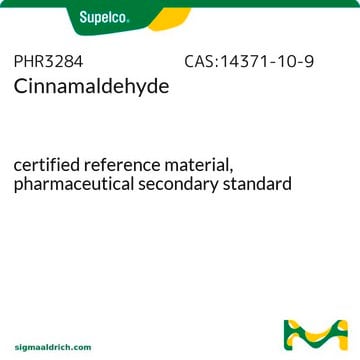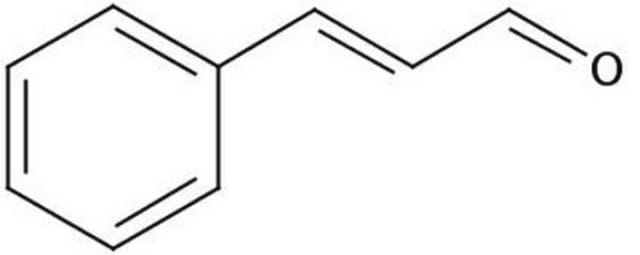06536
trans-Cinnamaldehyde
analytical standard
Synonym(s):
trans-3-Phenyl-2-propenal
About This Item
Recommended Products
grade
analytical standard
Quality Level
vapor density
4.6 (vs air)
Assay
≥95.0% (GC)
shelf life
limited shelf life, expiry date on the label
technique(s)
HPLC: suitable
gas chromatography (GC): suitable
refractive index
n20/D 1.622 (lit.)
bp
250-252 °C (lit.)
mp
−9-−4 °C (lit.)
density
1.05 g/mL at 25 °C (lit.)
application(s)
cleaning products
cosmetics
flavors and fragrances
food and beverages
personal care
format
neat
storage temp.
2-8°C
SMILES string
[H]C(=O)\C=C\c1ccccc1
InChI
1S/C9H8O/c10-8-4-7-9-5-2-1-3-6-9/h1-8H/b7-4+
InChI key
KJPRLNWUNMBNBZ-QPJJXVBHSA-N
Looking for similar products? Visit Product Comparison Guide
Related Categories
Application
- Pharmacological Activity in Metabolic Diseases: Cinnamaldehyde is investigated for its potential to attenuate diabetic osteoporosis in a rat model, mediated through the modulation of the netrin-1/DCC-UNC5B signaling pathway. This suggests its applicability in therapeutic strategies against metabolic bone diseases (Ji et al., 2024).
- Antibacterial and Biofilm Inhibition: The study reviews the inhibitory effects of natural compounds, including cinnamaldehyde, on the quorum sensing systems of Pseudomonas aeruginosa. This indicates its potential role in managing biofilm communities, which could be crucial for developing new antibacterial strategies (Shariati et al., 2024).
Packaging
Other Notes
Signal Word
Warning
Hazard Statements
Precautionary Statements
Hazard Classifications
Eye Irrit. 2 - Skin Irrit. 2 - Skin Sens. 1 - STOT SE 3
Target Organs
Respiratory system
Storage Class Code
10 - Combustible liquids
WGK
WGK 3
Flash Point(F)
159.8 °F - closed cup
Flash Point(C)
71 °C - closed cup
Choose from one of the most recent versions:
Already Own This Product?
Find documentation for the products that you have recently purchased in the Document Library.
Customers Also Viewed
Our team of scientists has experience in all areas of research including Life Science, Material Science, Chemical Synthesis, Chromatography, Analytical and many others.
Contact Technical Service









